Pregnancy Guide
Pregnancy, also known as gestation, typically spans approximately 40 weeks and is measured from the first day of a woman’s last menstrual period. Pregnancy is divided into three distinct stages known as trimesters.The gender and inherited traits of the baby are determined at the moment of conception, when the sperm fertilizes the egg.While calculating your due date is a useful guideline, it’s essential to note that babies often arrive when they are developmentally ready. Pregnancy duration can vary among women, and what’s considered “full term” spans from 37 to 42 weeks. Some babies may be born prematurely, before reaching the 37-week mark.
The typical progression of events during pregnancy begins with the initiation of conception.
A new individual comes into existence when the components of a potent sperm combine with those of a fertile ovum, or egg. Prior to this fusion, both the spermatozoon (sperm) and the ovum undergo significant journeys to meet and unite. Several actively motile spermatozoa are deposited into the vagina, navigate through the uterus, and reach the uterine (fallopian) tube, where they surround the ovum. The ovum, having been released from its follicle or protective capsule in the ovary, arrives in the tube. Upon entering the tube, the ovum sheds its outer layer of cells due to substances from the spermatozoa and the lining of the tubal wall. This shedding of the outer layer permits several spermatozoa to breach the egg’s surface, although typically only one spermatozoon becomes the fertilizing agent.
Once inside the ovum, the nuclear head of this chosen spermatozoon detaches from its tail. The tail gradually disintegrates, while the head, with its nucleus, endures. As it proceeds toward the ovum’s nucleus (now referred to as the female pronucleus), the head enlarges and transforms into the male pronucleus. These two pronuclei converge at the center of the ovum, where their threadlike chromatin material organizes into chromosomes.
Initially, the female nucleus possesses 44 autosomes (non-sex chromosomes) and two sex chromosomes (X, X). However, prior to fertilization, a specific type of cell division known as reduction division reduces the number of chromosomes in the female pro nucleus to 23, including a single X chromosome.
On the other hand, the male gamete, or sex cell, carries 44 automates and two sex chromosomes (X, Y). Through a similar reduction division process occurring before fertilization, it also contains 23 chromosomes, which include either an X or a Y sex chromosome at the moment of fusion with the female pronucleus.
Following the fusion of chromosomes and their subsequent division through a process known as mitosis, the fertilized ovum, now referred to as a zygote, undergoes a division that results in two daughter cells of equal size. In this mitotic division, each daughter cell inherits 44 autosomes, with half originating from the mother and half from the father. Additionally, each daughter cell possesses either two X chromosomes, indicating the development of a female individual, or one X and one Y chromosome, signifying the formation of a male individual. Consequently, the determination of the sex of these daughter cells relies on the specific sex chromosome inherited from the male parent.
Fertilization takes place within the uterine tube. The exact duration that the zygote remains within the tube remains uncertain, but it is likely to reach the uterine cavity approximately 72 hours after fertilization. Throughout its journey, the zygote is nourished by secretions from the mucous membrane lining the tube. By the time it arrives in the uterus, it has transformed into a solid mass resembling a mulberry, referred to as a morula. This morula comprises 60 or more cells.
As the number of cells within the morula continues to increase, the zygote undergoes a transformation into a hollow, bubble-like structure known as the blastocyst. The blastocyst, sustained by the secretions within the uterine environment, floats freely within the uterine cavity for a brief period before ultimately implanting itself into the lining of the uterus. Typically, the implantation of the blastocyst occurs in the upper portion of the uterine lining.
Determining the length of a pregnancy.
Save Time – An unborn baby usually spends 38 weeks in the womb, with an average gestation of 40 weeks.
Conception

Conception occurs when the woman’s egg is fertilized by the man’s sperm, determining gender and inherited traits.
This is due to pregnancy being calculated from the initial day of the woman’s last menstrual period, which typically precedes conception by approximately 2 weeks.
Pregnancy – week by week
Typically, there is a span of 266 to 270 days from ovulation to childbirth, with occasional variations between 250 and 285 days. Physicians commonly calculate the estimated due date by adding seven days to the first day of the last menstrual period and then projecting forward nine calendar months. For example, if the last period began on January 10, the estimated delivery date would be October 17. In legal contexts, such as determining a child’s legitimacy, courts may consider pregnancies of significantly shorter or longer durations as still falling within the possible range for gestation. For instance, a court in New York once accepted a pregnancy lasting 355 days as legitimate, while British courts have recognized 331 and 346 days as legitimate, with the endorsement of medical experts. Remarkably, fully developed infants have been known to be born as early as 221 days after the mother’s last menstrual period.
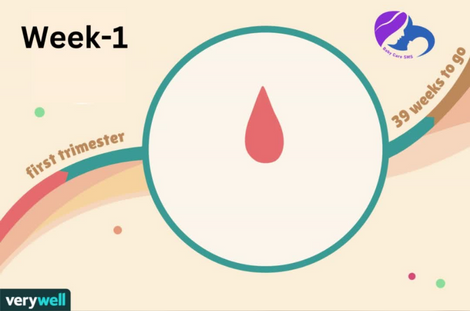
Pregnancy week 1
In the 40-week journey of pregnancy, the first week aligns with the onset of your menstrual period. This week plays a crucial role in the calculation of your Expected Birth or Due Date (EDD or EDB), which is derived from the initial day of your last menstrual period. It’s essential to emphasize that, although conception has not yet occurred, this week holds significance as an integral part of your pregnancy timeline. If you are aware of the date of your last period, you have the option to utilize a gestation calculator, which can provide you with a highly precise determination of your due date. This early phase sets the stage for the remarkable journey ahead, even before your baby is conceived.

Pregnancy week 2
Towards the end of this initial week, we anticipate the occurrence of conception, an extraordinary moment when your egg merges with sperm. This pivotal event marks the beginning of your remarkable journey into pregnancy. As the week progresses, the intricate processes of fertilization and cell division set the stage for the formation of a new life within you. It’s a profound and awe-inspiring moment, where the genetic material from both you and your partner combines to create a unique individual. While your baby’s development has just commenced, this milestone represents the starting point of an incredible transformation that will unfold over the next 40 weeks, ultimately leading to the birth of your precious child.
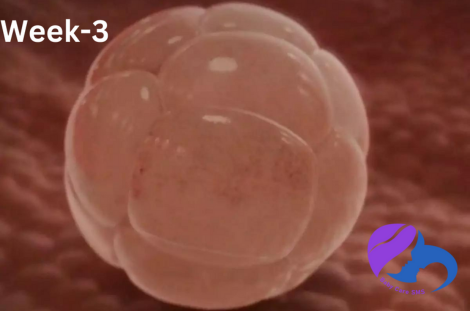
Pregnancy week 3
Roughly thirty hours after the moment of conception, the single-cell entity embarks on its initial division, yielding two cells. Within three days from that point, this cell, now referred to as a zygote, proceeds to undergo further divisions, culminating in a total of 16 cells. Two days later, this developing zygote makes a significant journey from the fallopian tube to the nurturing confines of the uterus, or womb. Finally, seven days after the inception of this extraordinary process, the zygote firmly implants itself into the thick uterine lining, scientifically known as the endometrium. At this pivotal juncture, it assumes the designation of a blastocyst, signifying a remarkable progression on the path to eventual fetal development and pregnancy.

Pregnancy week 4
The developing fetus is smaller than a grain of rice, with its cells dividing rapidly to build various body systems, including the digestive system.
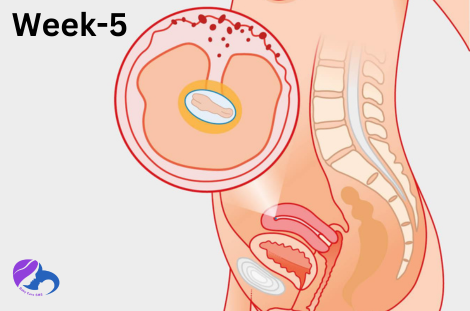
Pregnancy week 5
The developing neural tube will ultimately transform into the central nervous system, comprising the brain and spinal cord.
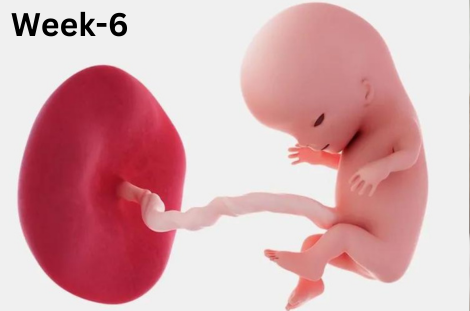
Pregnancy week 6
At this point, the entity is referred to as an embryo, measuring approximately 3 mm in length. At this stage, it produces specific hormones that inhibit the mother’s menstrual cycle.
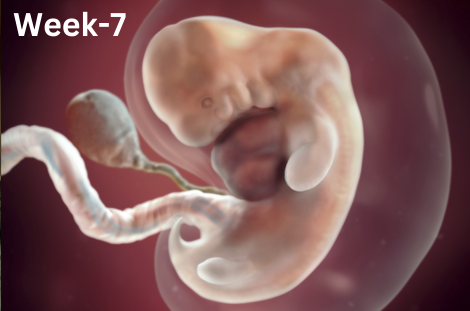
Pregnancy week 7
The embryo’s heart is now pulsating, and it has formed both the placenta and the amniotic sac. The placenta is in the process of embedding itself into the uterine wall to obtain oxygen and nutrients from the mother’s bloodstream.
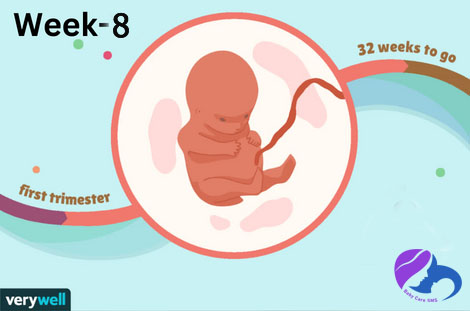
Pregnancy week 8
At this stage, the embryo measures approximately 1.3 cm in length. It exhibits a rapidly elongating spinal cord resembling a tail, while its head appears notably oversized in proportion.
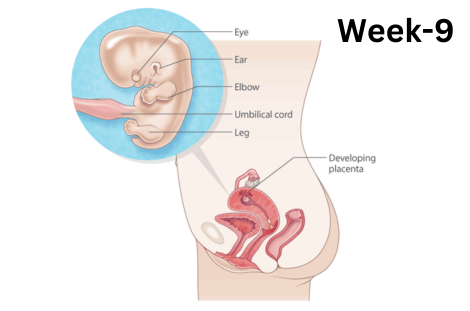
Pregnancy week 9
The eyes, mouth, and tongue are in the process of taking shape, and tiny muscles are enabling the embryo to initiate movement. Additionally, the embryo’s liver is actively producing blood cells.
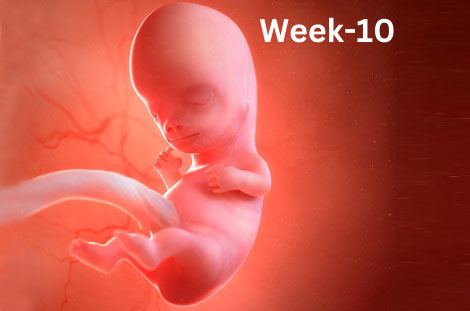
Pregnancy week 10
The developing embryo has now transitioned into a fetus, measuring approximately 2.5 cm in length. At this stage, all the essential organs have taken shape. The previously paddle-like limbs have begun to develop distinct fingers and toes. Additionally, the fetal brain is active, displaying discernible brain waves.
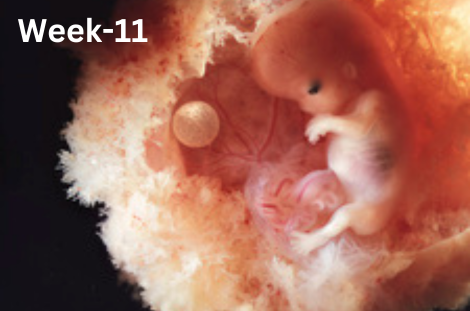
Pregnancy week 11
Teeth are emerging within the gum tissue, and the small heart is undergoing further development.

Pregnancy week 12
The fingers and toes have taken on recognizable shapes, yet they are still connected by webs of skin. Around this stage, the first trimester combined screening test, which involves a maternal blood test and an ultrasound of the baby, can be conducted. This screening assesses for the presence of trisomy 18 (Edward syndrome) and trisomy 21 (Down syndrome).
Second trimester of pregnancy – 13 weeks to 27 weeks
The second trimester of pregnancy typically spans weeks 13 to 14, bringing relief for many women as morning sickness subsides and energy levels improve.
During this phase, you may notice physical changes such as a visible pregnancy bump and some weight gain. A consistent and gradual weight gain is natural and crucial for both your well-being and your baby’s development. Nevertheless, it’s essential to maintain a balanced diet and engage in regular exercise to avoid excessive weight gain.
Gestational diabetes is commonly diagnosed between weeks 24 and 28 of pregnancy, although it can manifest earlier in some cases.
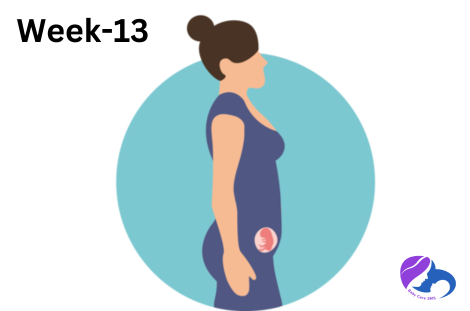
Pregnancy week 13
The developing fetus exhibits notable activity, displaying vigorous movements. It has now surpassed a length of 7 centimeters.
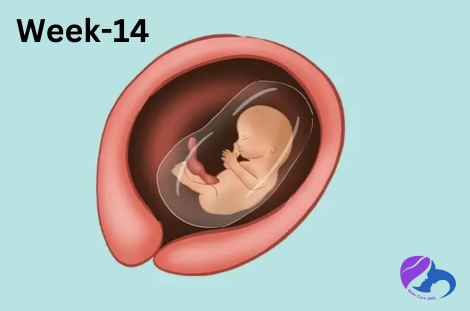
Pregnancy week 14
The eyelids have fused over the fully formed eyes. The baby is now capable of making silent cries, as its vocal cords have developed. It might even begin to soothe itself by sucking its thumb. Additionally, nails are beginning to form on the fingers and toes.

Pregnancy week 15
In this phase of pregnancy, your baby is going through a remarkable growth spurt. Weighing around 80 grams and measuring about 12 centimeters from head to bottom, they’re now about the size of an orange. The development of ear bones means they can hear sounds, including the comforting rhythms of your heartbeat, digestion, and your voice, even though their eyes remain closed. Your little one is also showing signs of developing motor skills, as they may start to suck their thumb, grip with their tiny fingers, squint, and even make facial expressions like grimacing. Additionally, a delicate layer of hair known as lanugo is beginning to appear across their body. It’s an exciting time as your baby’s senses and physical abilities continue to develop.

Pregnancy week 16
At this stage, the developing fetus measures approximately 14 centimeters in length. Notably, it has developed eyelashes and eyebrows, and its tongue now possesses taste buds. If the initial trimester screening was not conducted around week 12, the second trimester maternal serum screening will be recommended at this point.
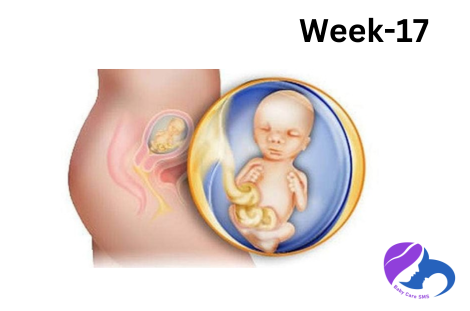
Pregnancy week 17
At 17 weeks into your pregnancy, your baby is on a rapid growth trajectory and weighs approximately 150 grams. Exciting developments continue as your baby’s eyebrows and eyelashes start to sprout, adding to their unique features. Although their eyelids remain closed, their eyes can now move, and their little mouth can open and close. In an intriguing twist, the lines on their tiny fingers have formed, giving them their own individual fingerprints. Fingernails and toenails are also in the process of growth, and your baby is already showing signs of a firm hand grip, all part of the incredible journey of development.
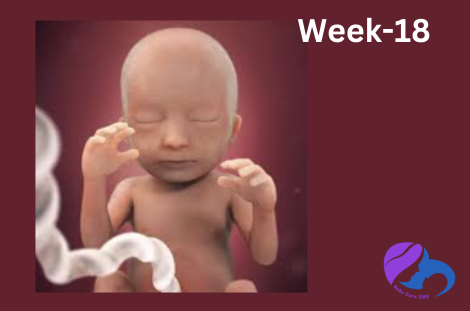
Pregnancy week 18
Your baby is quite active at this stage and might even react to loud external sounds, like music. It’s possible that you haven’t yet experienced these movements, especially if this is your first pregnancy. When you do, they will likely manifest as gentle flutters or rolling sensations.
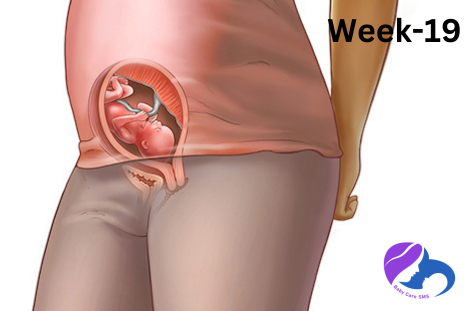
Pregnancy week 19
Your baby is gradually gaining some weight, but they haven’t accumulated much fat yet. If you could see your baby at this stage, you would notice a slightly wrinkled appearance. However, over the remaining weeks of pregnancy, your baby will continue to gain weight and will plump up significantly in the final stages before birth.
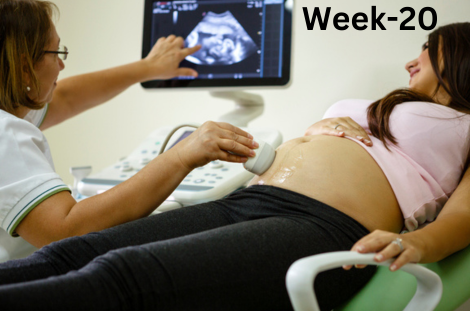
Pregnancy week 20
At approximately 21 centimeters in length, the fetus is making significant progress. Its ears are now fully functional, enabling it to perceive muffled sounds from the external environment. Additionally, distinct fingerprints have formed on its fingertips. Furthermore, an ultrasound scan can now distinguish the developing genitals, marking another milestone in its development.
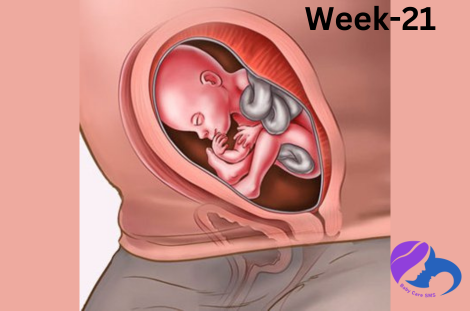
Pregnancy week 21
At 21 weeks, your baby tips the scales at approximately 350 grams. A noteworthy change is that, from this point onward, your baby’s weight surpasses that of the placenta, which was previously heavier. While the placenta continues to grow throughout the pregnancy, it can’t quite keep up with your baby’s pace.
Around this juncture, your baby develops a delicate, fine hair called lanugo, which covers their body. Although its precise purpose remains a mystery, it’s believed that lanugo might play a role in regulating the baby’s temperature. Typically, this lanugo naturally disappears before birth.
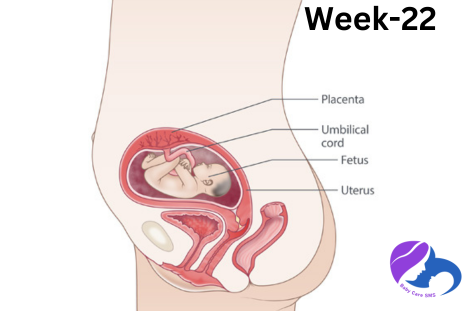
Pregnancy week 22
As your baby grows, they will establish their own sleep and wake schedule, which might not align with yours. While you’re winding down for the night, feeling calm and trying to rest, your baby might be wide awake and active.
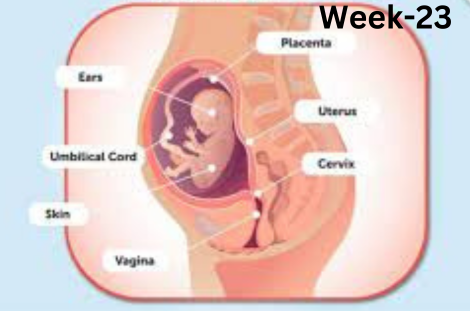
Pregnancy week 23
Your baby’s developing lungs are not fully functional yet, but they are practicing breathing movements in preparation for their life outside the womb.
Your baby continues to receive oxygen through the placenta and will do so until they are born.
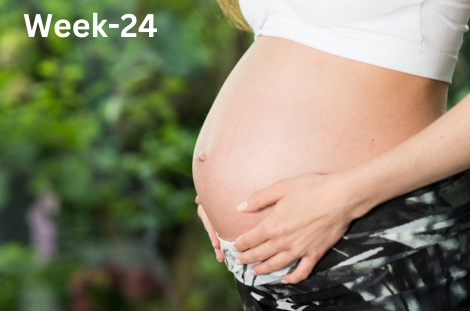
Pregnancy week 24
At this stage, the fetus measures approximately 33 cm in length. The previously fused eyelids have now separated into upper and lower lids, allowing the baby to open and close its eyes. The baby’s skin is adorned with fine hair known as lanugo and is shielded by a protective layer of waxy substance called vernix. Additionally, the baby is practicing breathing movements with its developing lungs.
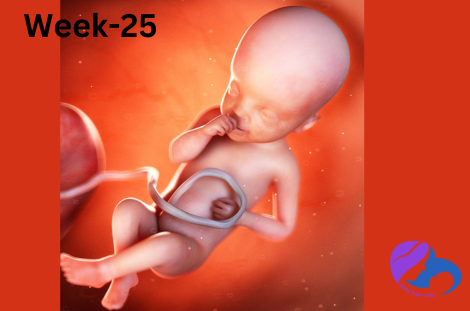
Pregnancy week 25
Your active baby is constantly in motion, reacting to both touch and sound. A particularly loud noise can elicit jumps and kicks that you can feel.
Additionally, your baby regularly releases urine into the amniotic fluid, and at times, you may sense the gentle jerks associated with their hiccups.

Pregnancy week 26
Around this time, your baby’s eyelids begin to open for the first time, and they will soon start the blinking reflex. However, it’s important to note that your baby’s eye color will not settle into its permanent hue until several weeks after birth.

Pregnancy week 27
At this stage, your baby’s heart rate will have decreased to approximately 140 beats per minute, which remains considerably faster than your own heart rate.
While your baby’s brain, lungs, and digestive system have taken form, they are not yet fully mature and continue to undergo development.
Third trimester of pregnancy – 28 weeks to 40 weeks
Throughout the third trimester, your baby experiences rapid growth, and you might notice an increase in your fatigue levels. As your baby continues to develop, you’ll observe changes in your body. In the later weeks, your baby will naturally descend and engage in your pelvis, a process often referred to as “dropping,” in preparation for birth.
As labor approaches, it’s common to feel anxious and may experience symptoms such as back pain, shortness of breath, and difficulties with sleep. It’s important to be aware that while preeclampsia can occur at any point in the second half of pregnancy, there is a heightened risk of its development during this stage.
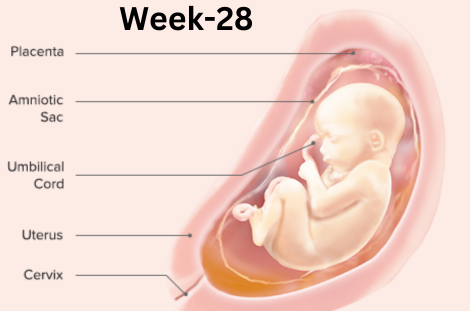
Pregnancy week 28
At this stage of development, your baby weighs approximately 1 kilogram (1,000 grams) or equivalent to 2 pounds and 2 ounces. The length from crown to rump measures about 25 centimeters (10 inches), with a total length from crown to toe reaching around 37 centimeters. Notably, the baby’s body has now reached a more balanced proportion, catching up with the earlier prominent head growth.

Pregnancy week 29
During this stage of pregnancy, your baby remains quite active, and you’ll likely notice a lot of movement. It’s important to note that there isn’t a specific quantity of movements you should expect daily, as every pregnancy is unique.
Instead, pay attention to your baby’s individual pattern of movements. If you notice any changes in this pattern, it’s essential to reach out to your midwife or hospital for guidance and support.
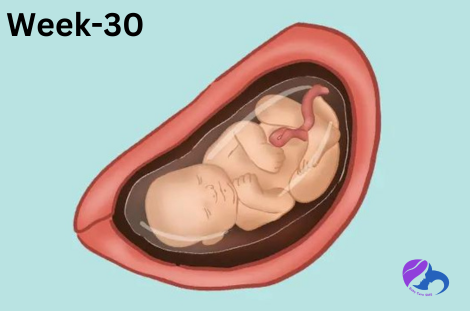
Pregnancy week 30
At this stage of development, your baby’s sucking reflex is emerging, allowing them to suck on their thumb or fingers.
Your baby is also gaining weight, resulting in a plumper appearance, and their skin is gradually becoming less wrinkled and much smoother.
Furthermore, the white, greasy substance known as vernix and the soft, fine hair called lanugo, which have covered your baby’s skin for a while, are starting to fade away.
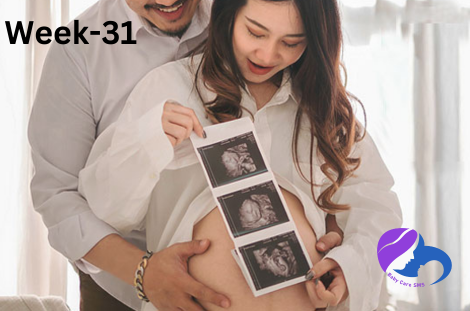
Pregnancy week 31
Your baby’s lung development is progressing rapidly, though they won’t be fully capable of independent breathing until around 36 weeks. Regular blood pressure checks during your appointments are vital, as high blood pressure poses risks to both you and your baby, potentially signaling pre-eclampsia. Look out for symptoms like severe headaches, vision issues, or rib pain. Understanding the initial days of breastfeeding can greatly assist in a successful start.
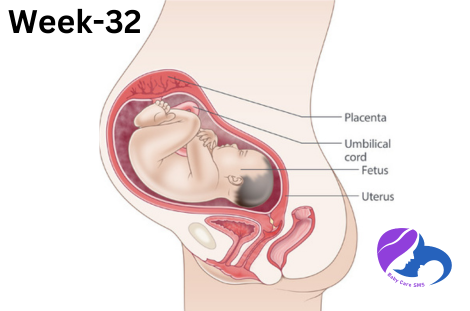
Pregnancy week 32
At this stage, your baby predominantly rests in a state of slumber, with strong and well-coordinated movements. It likely has positioned itself with the head down, getting ready for the upcoming birth.
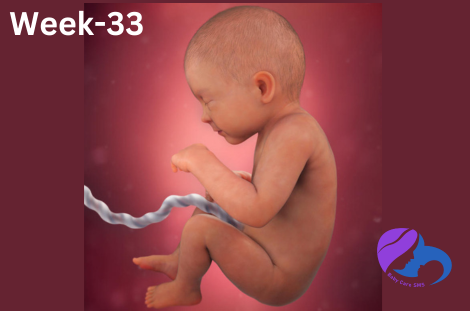
Pregnancy week 33
Around 33 weeks into pregnancy, your baby’s brain and nervous system reach full development. It’s important to limit caffeine intake during pregnancy to under 200 milligrams per day, equivalent to about 2 cups of tea and a can of cola. Heartburn, a common issue in pregnancy due to hormonal changes and pressure from the growing baby, can often be managed with diet and lifestyle adjustments. Consult your midwife or GP for treatment if needed. Your placenta, a vital organ, provides oxygen and nutrients to your baby while removing waste from their bloodstream as it grows within your womb.
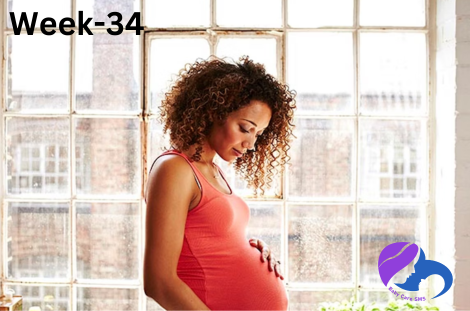
Pregnancy week 34
As your baby’s bones continue to harden, their skull bones remain soft and separate to ease passage through the birth canal, safeguarding the brain. Pre-eclampsia, a potentially serious pregnancy condition typically appearing after 20 weeks, is monitored through blood pressure and urine checks at midwife appointments. Recognize other signs like headaches, swelling, and vision issues. Gas and air (Entonox) is a pain relief option available during labor, even for home births.
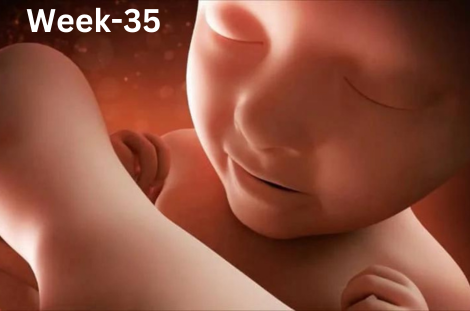
Pregnancy week 35
Your baby is now curled up in your uterus, with legs bent towards the chest. Though space is limited, they’ll still change position, and you’ll feel their movements and see them on your bump’s surface. Boys may see testicles descending into the scrotum. Premature labor, before 37 weeks, requires special hospital care. Extra weight may lead to fatigue and backache. Continue feeling your baby move until birth; any change warrants a midwife call. Avoid using home handheld devices (Dopplers) for baby checks, as they aren’t reliable indicators of well-being.

Pregnancy week 36
At approximately 46 cm in length, the baby has likely positioned its head within the mother’s pelvis, preparing for birth. If born at this stage, survival prospects are excellent. Rapid lung development continues over the next few weeks, further enhancing the baby’s readiness for life outside the womb.

Pregnancy week 37
At 37 weeks, your pregnancy is full-term, with an average baby weight of 3-4kg. Your baby is ready for birth, and you’ll meet them soon. Their digestive system now contains meconium, the initial greenish stool, possibly containing traces of lanugo. In first pregnancies, the baby descends, providing relief and lower abdominal pressure. In subsequent pregnancies, this descent may occur during labor. Nipple leakage is normal at this stage.
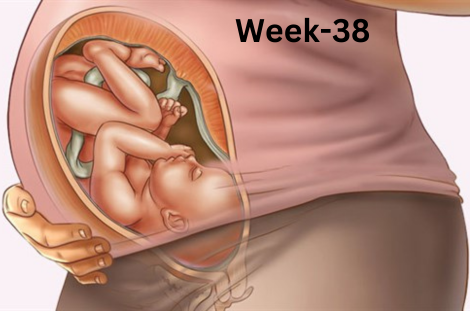
Pregnancy week 38
During labor, if your baby passes meconium, it can lead to monitoring due to potential stress. Labor typically occurs between 38 and 42 weeks. If overdue, your midwife or doctor will provide guidance, and you can refer to “Choices When Pregnancy Reaches 41 weeks” for more information. Contact your healthcare provider anytime if you have concerns about your baby’s movements, labor, or birth. Explore pain relief options and self-help strategies for managing contractions.

Pregnancy week 39
In the final weeks before birth, your baby’s head typically descends into the pelvis, known as “engagement,” possibly causing your bump to lower. Pre-eclampsia, a serious pregnancy condition, may not always show symptoms, but routine tests monitor blood pressure and urine for it. Watch for signs like severe headaches, vision issues, rib pain, and sudden swelling. Learn about labor signs and when to contact your midwife.

Pregnancy week 40
At about 51 cm in length, the baby is prepared for birth. The precise trigger for labor remains uncertain but is likely a blend of physical, hormonal, and emotional factors shared between the mother and baby.
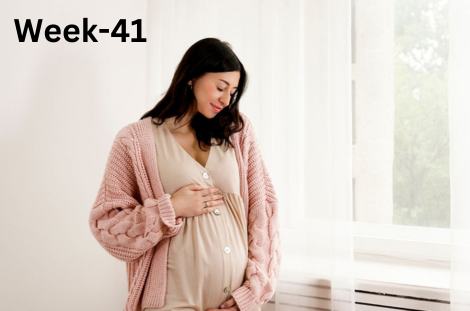
Pregnancy week 41
Newborns may have swollen genitals due to maternal hormones, but they typically normalize shortly. If you’ve had prior pregnancies, a membrane sweep may be offered at your 41-week appointment. This procedure involves a vaginal exam that can stimulate cervical hormones to potentially initiate natural labor, but it’s optional and should be discussed with your midwife.
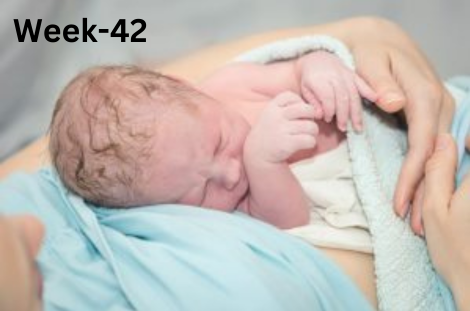
Pregnancy week 42
In most cases, labor typically commences by the 42nd week of pregnancy. If your pregnancy surpasses this timeframe and you opt not to induce labor, increased monitoring should be provided to ensure your baby’s well-being. Although most babies stay healthy, going beyond 42 weeks raises the risk of stillbirth. As it’s challenging to predict which babies are at greater risk, induction is recommended if labor hasn’t started by 42 weeks.
